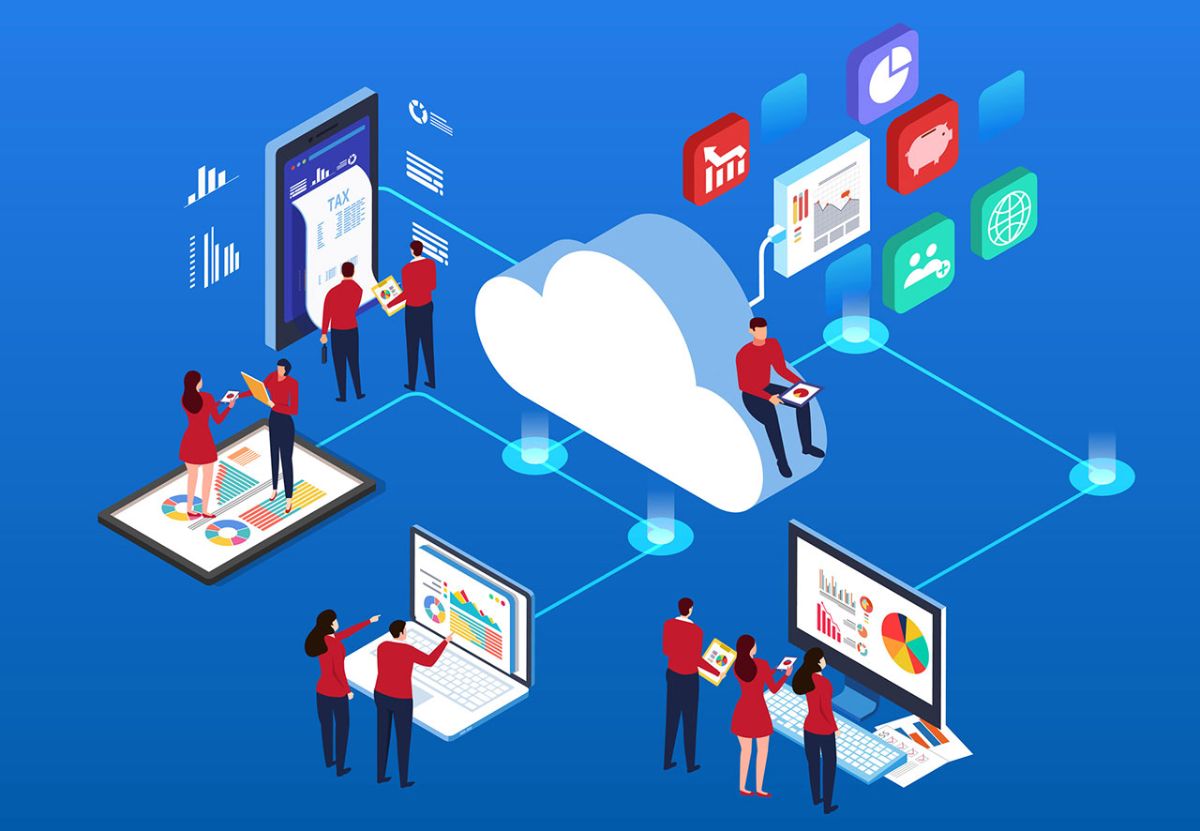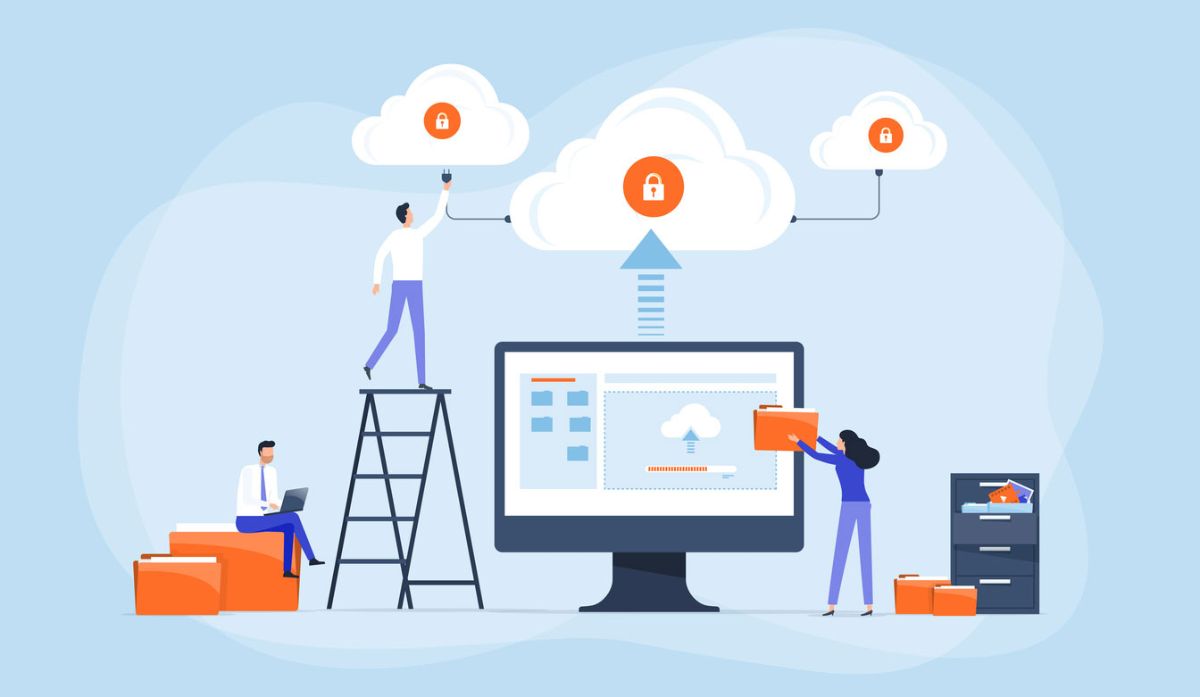The Sleeping Revolution Of Technology; Everything About Cloud Services
These Days, The Traces Of Cloud Technology Can Be Seen in All Fields. Stay With Us To Learn About Cloud Services In This Article.
Although cloud technology and cloud computing have been introduced for many years, it has become trendy in the last few years. Cloud computing has found its way into many industries since its introduction. This technology overcame concerns and proved its capabilities to support businesses and guide them toward success. Today, cloud computing is one of the inevitable changes to achieve success in the digital age.
What is cloud computing, and why is it important?
Cloud computing allows data and programs to be stored and accessed over the Internet instead of on hard drives, physical servers, or personal computers. Cloud computing uses a network of remote servers to store, manage, and process data instead of relying on local storage devices such as hard drives. A cloud is a group of servers that can be used online to store and share information.
Individuals and businesses use cloud computing to store their data remotely and can access this information from any computer or device with an Internet connection. For example, with cloud computing, you can send files to your colleagues or access your phone and computer images through programs such as Google Docs or Microsoft Word.
Using the cloud means that the servers you use are not located precisely in your physical location; Rather, it is possible to safely access them through the Internet. You can also save your data and backup files, just in case.

How does cloud computing work?
To better understand the performance of cloud computing technology, we must refer to three cloud technology implementation models:
public cloud
Cloud service providers host public clouds. Distributed over the public Internet, these clouds are the most popular and least expensive cloud model. This cloud provider includes Microsoft Azure, Amazon Web Service (AWS), and Google Cloud Platform.
private cloud
A private cloud acts as an independent entity. Some businesses build their environment, while others depend on other service providers. However, private clouds are expensive and have advantages. On the other hand, since some businesses have stricter privacy requirements, they choose private clouds.
hybrid cloud
A hybrid cloud combines public and private models that establish this connection through the Internet and virtual private networks. Companies can use a private cloud for their applications and sensitive data and a public cloud for workload control. The goal of a hybrid cloud is to create an automated and integrated environment that uses the advantages of public cloud infrastructure and, at the same time, the data privacy of the private cloud.
What is cloud computing service?
The purpose of cloud computing services is to improve the performance of businesses in all dimensions. Cloud computing services work by storing information in different locations called “data centers.” A data center may have thousands of networked computers, which makes it very powerful. In other words, the information is distributed among different physical devices and not stored in one place. Cloud computing services also have capabilities such as disaster recovery, high scalability, portability, and flexibility. These services help to save money, increase security and maintain the high quality of services.
Types of cloud services
There are three main types of cloud computing services:
- Infrastructure as a Service (IaaS)
- Platform as a Service (PaaS)
- Software as a Service (SaaS)
These services provide users with different levels of control and responsibility.
Infrastructure as a Service (IaaS)
With IaaS, the user manages everything from the operating system to the middleware, data, and applications. The service provider handles other tasks such as virtualization, server responsibility, storage, and networking. Users pay based on their resources, such as CPU cycles, memory, bandwidth, and more. Examples of IaaS products include Amazon Web Services and Microsoft Azure.
Some businesses use IaaS as a “cloud migration” strategy to move data and applications to the cloud. For example, a small business may move its files, email, and web servers to the cloud instead of physical storage.
Others use IaaS as part of a disaster recovery plan. Cloud service providers store different backups in different data centers. The data is safely stored elsewhere, even if a problem occurs in one of the data centers. This way, businesses can recover their data in case of a ransomware attack, accidental deletion, or disasters such as floods, fires, or other natural disasters.
Finix is a prime example of IaaS that companies and businesses can use to increase the efficiency of their internal payment process. The service also provides reporting mechanisms to organizations. Digital Ocean is another example of IaaS that helps businesses build multiple virtual machines in just a few seconds. In this way, organizations can efficiently manage their products and, at the same time, increase their data storage based on incoming traffic.
Platform as a Service (PaaS)
Platform as a Service (PaaS) applications provides users with an environment for developing, testing, and hosting applications. The user manages his data and software, and the service provider performs other responsibilities. With PaaS, there’s no need to worry about software, operating systems, or memory updates. Users can pay for any resource they need. Examples of PaaS include Google App Engine or SAP Cloud.
Pager Duty is an example of a PaaS that helps businesses implement incident management. Companies can monitor new incidents on an instant basis. It also benefits them in terms of data collection and task distribution.
Software as a Service (SaaS)
In the SaaS model, users purchase licenses to use an application. Unlike IaaS and PaaS models, users typically buy monthly or annual subscriptions rather than a specific resource. Some famous examples of SaaS include Microsoft 365, Dropbox, and DocuSign.
The SaaS model is helpful for small businesses that lack the financial or IT resources to develop the latest and most excellent solutions. With this model, there is no room for financial or labor concerns.
Applications of cloud services
Cloud computing is essential in optimizing interactions by providing remote assistance. Cloud services are used for personal and business purposes. In the following, we look at real examples and cloud computing applications.
1. File upload and download platform
The online upload and download platform is an example of a cloud application. Many upload and download platforms allow end users to host files, documents, videos, and images on the cloud. These platforms usually have a simple user interface for displaying and uploading documents from personal computers to the sites. Access to these services is possible for free and paid. Users can access premium services by paying monthly.
Examples: Media Fire, Hot File, and Rapid Share
2. Art programs
Cloud computing services have been used in a variety of art programs that can be used to design books, cards, and creative, attractive images. These programs provide editing services to users and can be used as simple desktop programs on designers’ personal computers.
Samples:
Vistaprint and Adobe Creative Cloud are examples of cloud-based art programs or services. These programs help designers in editing designs.
3. Edit images
Many cloud services allow users to edit images for free. These services provide facilities such as resizing, editing, cropping photos, and using special effects with a simple user interface. In addition, contrast and brightness settings are available to users.
Examples: Fotor and Adobe Creative Cloud

4. Data storage
Today, many applications based on cloud computing models have been released. These programs allow for storing information in the cloud. Such clades can be private or public. You can store data, files, and images on these clouds. Cloud storage services also provide data format conversion services to users.
Examples: DropBox, OneDrive, Box, Mozy, and Google Suites
5. Antivirus
Cloud services also provide support and antivirus services. Cloud Antivirus software helps users to clean the system at regular intervals. This service offers the possibility of upgrading and integrating the system’s operation.
With these services, you can detect and identify malware threats and viruses. Such programs are usually free, and by detecting threats, they send a report to the cloud data center where the problem of users is solved.
Examples: Sophos Endpoint Protection, Malwarebytes, ESET Protect Entry
6. Fun and games
Streaming video games usually require high bandwidth and high-speed Internet access, which is why cloud gaming will be more prevalent in 2023 with the introduction of 5G technology. Cloud service providers offer a multi-cloud strategy. This strategy helps entertainment programs interact with the audience. Online gaming services are in this category.
Samples:
Microsoft’s xCloud, Nvidia’s Geforce Now, Sony’s Playstation Plus, Amazon’s Luna
7. Film and video
With cloud video streaming, you can watch digital content without downloading it. This technology allows users to access their favorite video content on any device. It also provides access to quality video content at a lower cost than traditional video streaming methods.
Examples: Netflix, Vimeo, Hulu

8. Convert URLs
Many cloud services offer URL-shortening services. Here URL stands for “uniform resource locator.” This service converts long URLs into short versions. Many cloud-based social networking applications use URL shortening or conversion services to protect against malware and hacking services. These services also allow easy management of URLs.
Samples:
Bitly is one of the critical examples of a URL-shortening service. This service helps to create short URLs and redirects to the original website.
9. Holding a web meeting
Most cloud computing services offer virtual servers with good meeting capabilities. These services facilitate video conferencing and other meetings and allow users to start the discussion virtually.
These services can be used for personal or business meetings. This way, users can connect with others in just a few seconds and use presentation and screen-sharing features.
Samples:
Zoom and GoTo are critical examples of cloud-based meeting applications. These programs enable smooth video conferencing and cloud-based presentation services.
10. Presentation
There are specific cloud-based applications for creating formal presentations. These programs also provide the necessary storage space to maintain new and previous exhibitions, allowing end users to access their presentations anywhere in the world.
Samples:
Slide Rocket is one of the leading cloud computing applications that help users draft and customize formal presentations.
11. Social Networks
Many cloud-based social networking applications allow users to connect instantly. These applications enable the simultaneous connection of millions of users by providing a collaborative user interface.
Samples:
Facebook, Yammer, Twitter and LinkedIn. These applications provide facilities such as sharing videos, images, and stories with users.

12. GPS
One of the critical developments in cloud computing services is providing GPS-based services to users. GPS provides real-time positioning services. This is the secret word of the Global Positioning System. Users can find their routes on the map using an internet connection.
Samples:
Prominent examples of cloud GPS are Google Maps and Yahoo Maps. These services are open source and free and are used by millions worldwide.
13. Internet of Things (IoT)
The Internet of Things is a well-known trend in cloud computing. This technology establishes a connection between computers, servers, and networks and helps to collect data from remote devices by establishing a successful relationship.
Samples:
Google Cloud IoT, Microsoft Azure IoT Hub, IBM Watson IoT Platform
14. Blockchain
A blockchain is a linked list of blocks containing records that grow incrementally. In the blockchain, cryptography is used to store data inside blocks. Today, this technology is used together with the cloud, so it is possible to process a large amount of data and control it better. In this way, security, transparency, and high decentralization are provided.
Samples:
Amazon Managed Blockchain and Oracle Blockchain are services that use blockchain infrastructure.
15. Accounting
Cloud accounting applications help users track expenses and manage profits and capital instantly.
Samples:
Outright is one of the best examples of cloud-based accounting applications. Some other examples are Zoho books and Kash flow.
16. Management
Project management apps help users document and share notes with multiple stakeholders instantly. This way, project management stakeholders can refer to prepared and saved notes. These applications are usually offered to users for free with premium features and are designed to meet the business and personal goals of users.
Example: Evernote
17. electronic commerce
Cloud computing services are also leading the way in e-commerce services. Several e-commerce applications provide access to online storage services. Such applications have variable tracking mechanisms that allow tracking the status of order receipt and delivery and help business owners understand tracking costs, order refund rates, and business loss rates. Business owners can save time and effort on the tracking process with these apps.
Examples: Amazon, eBay

18. Data monitoring and cyber security
Organizations can protect their sensitive data with cyber security cloud services. Such services offer unique features to protect against intrusion.
Samples:
Z-Scalar acts as a zero-trust platform, connecting users remotely to any device or application on any network. This service provides users with a safe and flexible work environment.
Carbonite cloud is another example of cloud cyber security capability that protects information and data from possible ransomware. It also significantly reduces security intrusions. Forcepoint is another example of a cloud service offering users cyber security capabilities.
19. Backup and restore
Cloud service providers and vendors also provide security and data backup services. Data can be adequately backed up with these services. If data is lost, recovery services help to get it back quickly.
Traditional data recovery methods have become a complex problem. Sometimes recovering lost data can be time-consuming and costly. However, cloud computing removes these limitations and provides stable backup and recovery solutions.
Samples:
Examples of backup and recovery solutions include Idrive personal, Backblaze, and CrashPlan for small businesses.
20. Test and development
Cloud computing provides platforms that help in the instant testing and development of IT resources. These platforms ensure resource availability and service delivery. Such services are usually inexpensive, and organizations can provide flexible and scalable IT products or services with their help.
Samples:
SOASTA Cloud Test, Load Storm, and BlazeMeter
21. big data analysis
Cloud services also help to manage and organize big data. Big data is a collection of growing data with significant complexity and volume. Legacy computing mechanisms usually provide limited capabilities for managing big data, while cloud computing eliminates the need for physical memory for better extensive data management. In addition, cloud computing enables comprehensive data analysis. In this way, organizations should increase the speed of decision-making.
Samples:
Hana, Hadoop, Apache
22. Education
Distance education applications have been one of the notable achievements of cloud computing in recent years. This technology helps facilitate online education by enabling the development of distance learning platforms.
Such systems allow students to track and monitor overall school performance. They also increase the attractiveness of the learning experience for teachers, students, researchers, and students. Educational institutions save on physical infrastructure and maintenance costs by using these systems. In addition, to promote participation and distance learning, each student and member of the institution can have their own space through username and password. In this way, the data can be accessed from any point.
Samples:
Examples of cloud education applications include Canvas, Coursera, Blackboard, and Google Classroom.

Conclusion
Cloud computing eliminates the need for physical storage systems while enabling secure communication by providing services. With cloud services, you can save time and money and access data and benefits from a desired geographic location. By adopting cloud technology, organizations can significantly reduce their infrastructure costs and, on the other hand, maximize productivity.











